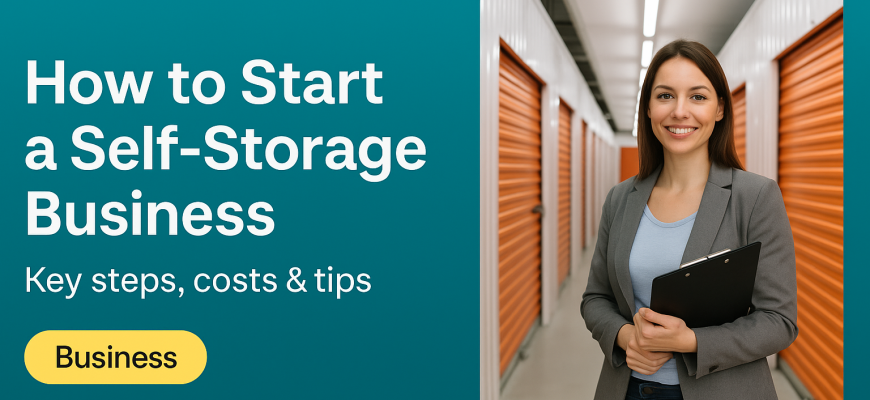Думаете о запуске собственного бизнеса по самостоятельному хранению? Вы в отличном положении! Индустрия самостоятельного хранения в США процветает – с более чем 52 000 учреждений по всей стране и примерно $44,3 млрд. в годовом доходе. Это означает, что миллионы клиентов арендуют помещения каждый месяц, чтобы безопасно разместить свою мебель, праздничные украшения, транспортные средства, бизнес-инвентарь и многое другое. Лучше всего то, что хорошо управляемый бизнес по хранению может быть высокоприбыльным (типичная чистая прибыль составляет около 11%), зачастую выше, чем у многих других малых предприятий.
Как бизнес-тренер для женщин, я знаю, что сфера хранения уже не является исключительно «мужской отраслью». Женщины-предприниматели ломая стереотипы и преуспевая как лидеры в сфере самостоятельного хранения. На самом деле, у вас, скорее всего, уже есть много сильных сторон – коммуникативные навыки, умение строить отношения и основательное планирование – которые могут выделить ваш бизнес по хранению. Это руководство проведет вас через каждый шаг на понятном языке, чтобы вы могли уверенно воплотить эту идею в реальность.
Понимание модели самостоятельного хранения
Предприятие по самостоятельному хранению вещей по сути сдает в аренду безопасные помещения (или «блоки») частным лицам и компаниям на условиях ежемесячно основе. Клиентам могут понадобиться единицы, когда они переезд, сокращение, ремонт или просто нужно дополнительное пространство. Например, вы можете обслуживать жильцов квартир, у которых нет шкафов для сезонных вещей, семьи, хранящие семейные реликвии, или местные компании, хранящие инвентарь без склада. Ваше учреждение предоставляет чистое и безопасное место для этих вещей.
Доход поступает от арендная плата и любые дополнительные услуги (например, продажа замков, ящиков, страховка или даже аренда грузовиков). Прибыль во многом зависит от насколько заполнен ваш объект и насколько выгодно вы устанавливаете цены на свои единицыПочти пустой склад — это убыточный источник дохода, в то время как высокозаполняемый склад обеспечивает стабильный денежный поток. Хорошая новость заключается в том, что складские помещения часто имеют более низкую безубыточную заполняемость, чем многие компании, а это значит, что вам не нужно арендовать все помещения, чтобы начать получать прибыль. По мере ежемесячного заполнения помещений ваш доход растёт, но основные расходы (например, выплаты по кредиту или ипотеке) остаются практически неизменными. Короче говоря: больше арендных платежей = больше выручка, поэтому поддерживайте высокий уровень маркетинга и обслуживания, чтобы поддерживать заполняемость.
Исследование рынка и местоположения
Прежде чем инвестировать в землю или здание, проведите домашнюю работу по местный рынок и конкуренция. Вот ключевые факторы для исследования:
-
Население и рост: Является ли район густонаселенным (например, 20 000+ человек в сельской местности или 100 000+ в городе)? Большая численность населения обычно означает больше потенциальных клиентов. Также обратите внимание на тенденции роста: растет или сокращается сообщество? Больше людей переезжает, больше спроса.
-
Потребности клиента: Что нужно местным жителям? Много ли квартир и пожилых людей, которые переезжают на новое место жительства и которым может понадобиться дополнительное место для хранения? Или поблизости есть небольшие предприятия (например, подрядчики или организаторы мероприятий), которые могут хранить инструменты и расходные материалы? Знание того, кто будет арендовать у вас жилье, поможет вам подобрать типы единиц (климат-контроль, подъезд, хранение транспортных средств/домов на колесах и т. д.) и услуги.
-
Движение и видимость: Складские помещения полагаются на проезжающий транспорт и сарафанное радио. Ваш участок находится на оживленной улице или рядом с автомагистралями? Хорошая видимость и легкий доступ привлекают больше случайных клиентов.
-
Соревнование: Сколько складских помещений уже есть в этом районе и как они справляются? Проедьте мимо или проверьте онлайн-объявления о наличии близлежащих объектов. Обратите внимание на их заполняемость, цены, часы работы и характеристики. Если они заполнены, это хороший признак спроса; если они полупустые, спросите, почему. Также проверьте, планируются ли какие-либо новые объекты (слишком большое предложение может повредить вашим ценам).
-
Цены и предложения: Какие размеры и ставки устанавливают конкуренты? Это поможет вам установить конкурентоспособные цены. Например, в оживленном районе метро арендная плата за складские помещения может варьироваться от 50¢–$4 за квадратный фут в месяц в зависимости от размера и удобств.
Используйте это исследование, чтобы написать простую бизнес-план или планОн не должен быть длинным, но в нём должно быть понятно, кто ваши клиенты, какие типы помещений вы будете предлагать и чем вы будете выделяться (более безопасное местоположение, лучшее обслуживание, более низкая цена, нишевое хранилище и т. д.). Даже одностраничный план поможет вам продумать детали и будет необходим, если вы позже захотите получить кредит. (Совет: в интернете есть бесплатные шаблоны, а такие организации, как SCORE, предоставляют бесплатные консультации, чтобы помочь начинающим предпринимателям с планированием.)
Создание юридической и финансовой основы
Теперь, когда вы знаете, что и где, пришло время заложить основу в юридическом и финансовом плане.
-
Выберите структуру бизнеса: Большинство владельцев небольших складов создают ООО или корпорацию для защиты личных активов. Изучите, что имеет смысл для вас (ООО распространено из-за своей простоты и защиты ответственности). Вы подаете документы в свой штат, выбираете название и платите небольшую пошлину.
-
Регистрация и лицензия: Получите идентификационный номер работодателя (EIN) в Налоговой службе США (он доступен бесплатно онлайн). Откройте банковский счёт для бизнеса, чтобы ваши средства на хранение хранились отдельно от личных. Ознакомьтесь с местными требованиями: вам может потребоваться общая лицензия на ведение бизнеса или разрешения на ведение деятельности, а также, конечно же, разрешение на зонирование или сертификат о вводе в эксплуатацию, если вы строите или реконструируете объект. (Не пропустите этот шаг! Работа без необходимых лицензий или разрешений может привести к штрафам или даже принудительному закрытию.)
-
Страхование: Складские предприятия обычно нуждаются в страховании ответственности и страховании имущества (покрывающем здание и содержимое). Если вы планируете продавать клиентам страховку (обычно для защиты хранящихся предметов), проверьте, нужна ли вам лицензия на страхование или партнерство с брокером. При необходимости поищите полис, который покрывает такие вещи, как наводнение или штормы.
-
Составьте бюджет и получите финансирование: Составьте таблицу всех первоначальных расходов (покупка или аренда земли, строительство или реконструкция, установка ограждений и ворот, обустройство офиса, веб-сайт, вывески и т. д.). В среднем строительство нового небольшого объекта может стоить от нескольких сотен тысяч до более миллиона долларов, хотя покупка существующего или использование перепрофилированного пространства может обойтись дешевле. Подумайте о том, как вы будете финансировать проект: личные сбережения, банковские кредиты или инвестиции. Популярным вариантом является кредит SBA 7(a); он может покрывать расходы на землю, строительство или покупку объекта. SBA также предлагает программу 504 для недвижимости и оборудования. Будьте готовы предоставить свой бизнес-план и кредитную историю. Если денег мало, рассмотрите партнёров или начните с малого (см. следующий раздел), пока не будете готовы к более крупному проекту.
-
Ведите точные записи: Сразу же настройте бухгалтерский учет — либо программное обеспечение (например, QuickBooks), либо наймите бухгалтера. Отслеживайте все расходы и доходы. Надежная настройка бухгалтерского учета поможет вам при подаче заявок на кредиты, управлении денежными потоками и, в конечном итоге, при подаче налоговых деклараций.
Выполнение этих шагов рано создает прочную основу. Используйте бесплатные ресурсы (во многих сообществах есть Центры развития малого бизнеса) или наставников, которые будут вас направлять. Каждый пройденный вами шаг (регистрация ООО, открытие счетов, составление бюджета) — это прогресс, который вы можете отпраздновать.
Проектирование или обеспечение безопасности вашего объекта
Пока идет оформление документов, обратитесь к физическая сторона: само ваше хранилище. В зависимости от бюджета есть два основных пути — строительство/приобретение выделенного хранилища или поиск креативной недорогой альтернативы.
-
Покупка существующего объекта: Это может сэкономить время. Проверьте списки складских предприятий на продажу. Цены сильно различаются (менее $1M в сельской местности, до миллионов в городах). Если вы покупаете, проверьте его финансовые показатели, заполняемость, состояние единиц и любые скрытые расходы. Вам все равно придется сделать ребрендинг, установить собственное программное обеспечение и, возможно, сделать ремонт или модернизацию.
-
Новое здание: Если земля доступна, вы можете построить объект, соответствующий вашему плану. Проконсультируйтесь с проектировщиком, имеющим опыт в планировке складских помещений. Основные характеристики для планирования включают размеры блоков (5×5, 10×10, 10×20 являются обычными), подъезд для автомобилей, секции с контролируемым климатом (для чувствительных предметов), безопасность (ограждение, камеры, освещение) и офис или киоск. Одноэтажный объект может стоить около $50–$65 за квадратный фут для строительства. Учитывайте подготовку участка (выравнивание, мощение), подключение к коммуникациям и благоустройство. Тесно сотрудничайте с подрядчиками и проверяйте требования к зонированию. Закладывайте дополнительные средства — проекты часто немного выходят за рамки бюджета.
-
Недорогие альтернативы: Если вышесказанное слишком большой скачок, рассмотрите креативные модели. Например, хранение контейнеров для транспортировки это растущая тенденция: вы арендуете или покупаете землю (даже временно) и выстраиваете ее стальными контейнерами, которые служат единицами. Это сокращает расходы на строительство и позволяет вам расширяться по мере роста спроса. Другая идея — мобильное хранилище модель (подумайте о PODS), где вы доставляете контейнер к клиенту домой для загрузки, а затем храните его на своей площадке. Вы даже можете начать с аренда склада в краткосрочной перспективе и разделив его на единицы, чтобы проверить спрос. Некоторые предприниматели сотрудничают с местными владельцами недвижимости — например, используя землю фермера для хранения автофургона — чтобы избежать покупки земли напрямую.
Будь то строительство или аренда, Местоположение и планировка имеют решающее значениеВыберите парковку с удобным доступом и безопасным расположением (хорошее освещение, хорошая видимость). Убедитесь, что есть место для разворота крупногабаритных автомобилей. Внутри используйте прочные материалы (стены из гофрированного металла, бетонные полы, замки, устойчивые к атмосферным воздействиям) и чёткие указатели. Оборудуйте офис или киоск с компьютерной системой бронирования и оплаты. В это же время нужно установить программное обеспечение для управления, чтобы всё было готово к открытию.
Управление операциями и обслуживанием клиентов
Отличный дизайн — это только часть истории: как вы бегать бизнес имеет огромное значение. Планируйте ежедневные операции и стремитесь создать положительный опыт для арендаторов:
-
Безопасность и обслуживание: Сделайте безопасность своим главным приоритетом. Установите надёжные ворота (с кодовым замком или картой доступа), яркое освещение в проходах и камеры видеонаблюдения. Напоминайте клиентам о безопасности их вещей, что укрепляет доверие. Более того, информируя арендаторов о таких функциях, как круглосуточное видеонаблюдение и контролируемый доступ, вы можете быть уверены в сохранности их имущества. Регулярно осматривайте территорию: расчищайте проходы, обрезайте заросли и оперативно устраняйте любые повреждения. Ухоженный объект привлекает хороших арендаторов и оправдывает ваши ставки.
-
Технологии и программное обеспечение: Используйте систему управления хранилищем (существует много доступных вариантов) для управления выставлением счетов, арендой и инвентаризацией. В идеале выберите программное обеспечение, которое предлагает онлайн-аренда и платежи – арендаторы любят удобство бронирования жилья и оплаты из дома. Автоматизация выставления счетов и штрафов за просрочку платежа также экономит время и сокращает количество ошибок.
-
Обслуживание клиентов: Будьте дружелюбны, терпеливы и отзывчивы. Когда потенциальный клиент или арендатор звонит или приходит в гости, приветствуйте его тепло. Четко отвечайте на его вопросы о размерах и ценах. Помните: если вы производите на кого-то негативное впечатление (например, пренебрежительно или медленно отвечаете), исследования показывают, более половины клиентов могут уйти после всего лишь одного негативного опытаЧтобы избежать этого, общайтесь с клиентами понятно — например, точно сообщите им, как с вами связаться (по телефону, электронной почте или даже в текстовом сообщении) для получения помощи. Подумайте о том, чтобы предложить советы по упаковке или скидку за рекомендацию друга; даже небольшие детали помогут вам выделиться.
-
Политика и цены: Устанавливайте арендную плату в соответствии со спросом. Предложение акций (например, скидки за первый месяц или гибкий график оплаты) поможет быстро заполнить жилье. Четко пропишите в договоре аренды информацию о штрафах за просрочку, уведомлении о выезде и способах оплаты. Профессионально обращайтесь с просроченными платежами: вежливо реагируйте на просрочку и следуйте юридическим процедурам, если арендатор перестает платить. Последовательность и честность помогут создать хорошую репутацию.
-
Дополнительный доход: Думайте не только о единицах товара. Вы можете продавать упаковочные материалы (коробки, скотч, пузырчатую плёнку) и замки или арендовать оборудование для переезда (тележки, ручные тележки). Вы также можете сотрудничать со страховыми компаниями и получать комиссию за привлечение клиентов, если они приобретают страховку на хранение. Каждое дополнительное преимущество может улучшить вашу прибыль и повысить удовлетворенность клиентов.
Управление складским бизнесом больше похоже на розничную торговлю, чем на пассивную недвижимость: речь идет о обслуживание и эффективностьПоддерживая чистоту в помещениях, обеспечивая надежную охрану и доброжелательное обслуживание, вы побуждаете клиентов оставаться в вашем доме (и рассказывать о нём другим). Помните: лояльные арендаторы заполняют вакантные места и в долгосрочной перспективе экономят ваши маркетинговые усилия.
Запуск и продвижение вашего бизнеса
Вы проделали тяжелую работу – теперь пришло время открыть двери с всплеском и сохранить импульс. Сильный запуск поможет быстро заполнить подразделения и запустить сарафанное радио:
-
Торжественное открытие: Запланируйте небольшое мероприятие по случаю открытия (даже вывеску «Торжественное открытие» и местный пресс-релиз). Предложите ограниченную по времени акцию (например, скидку 50% на первый месяц или бонус за привлечение клиентов). Проводите экскурсии для местных лидеров или даже для местных компаний по переездам. Небольшой предварительный фурор очень важен.
-
Онлайн-присутствие: Создайте простой, удобный для мобильных устройств сайт с указанием местоположения, вариантов размещения и способа связи или бронирования. Добавьте свою компанию в Google Мой бизнес, чтобы люди могли найти вас на картах. Убедитесь, что ваш объект представлен на площадках для самостоятельного хранения, таких как SpareFoot или PublicStorage — многие арендаторы начинают поиск онлайн. Следите за актуальностью часов работы и контактной информации.
-
Локальный маркетинг: Раздавайте листовки или рекламные карточки в близлежащих районах (университетских кампусах, агентствах недвижимости, жилых комплексах) и присоединяйтесь к группам сообщества в Facebook или Nextdoor, чтобы рассказать о своем новом бизнесе. Если у вас есть бюджет, рассмотрите возможность рекламы в Интернете (реклама в Facebook или Google Ads с таргетингом на ваш почтовый индекс). Никогда не недооценивайте силу дружеской беседы с соседом или владельцем местного магазина — рекомендации часто становятся началом личного общения.
-
Партнерские отношения: Обратитесь к компаниям, занимающимся переездами и хранением: местным мувинговым компаниям, компаниям по организации домашнего жилья или даже дизайнерам интерьеров. Предложите им небольшую комиссию за поиск или бесплатное первое использование. Домовладельцы и компании, переезжающие в ваш район, оценят надёжную рекомендацию.
-
Текущее взаимодействие: Следите за телефоном и электронной почтой на случай возникновения вопросов. Быстро отвечайте на каждый вопрос. После того, как клиенты въедут, отправьте им сообщение с благодарностью или напоминание до внесения первого платежа. Поощряйте оставлять отзывы: довольные клиенты, оставляющие пятизвёздочные отзывы в интернете, имеют большое значение. Даже короткий отзыв в Facebook или Google может укрепить доверие будущих арендаторов.
-
Последовательный маркетинг: Не стоит забывать об этом. Регулярно проверяйте заполняемость. Если появляются свободные помещения, активизируйте рекламу или запустите акцию. Если вы заметили, что арендаторы просят что-то конкретное (например, больше квартир с климат-контролем), составьте план по реализации этого. Вовлеченность и гибкость обеспечат рост вашего бизнеса.
Шаг вперед с уверенностью
На первый взгляд запуск бизнеса по самостоятельному хранению может показаться сложным, но, разбив его на четкие этапы, вы сможете справиться с одним этапом за раз. Помните: у тебя есть этоМногие женщины построили успешный бизнес в сфере хранения данных, используя свои сильные стороны: чёткую коммуникацию, организованность и индивидуальный подход, чтобы выделиться. Воспользуйтесь доступными ресурсами: бесплатные наставники SCORE, программы для малого бизнеса и отраслевые сети готовы помочь.
Каждый путь начинается с одного шага. Понимая модель, проводя тщательное исследование, соблюдая юридические нормы, вдумчиво разрабатывая дизайн и управляя клиентоориентированной деятельностью, вы прокладываете путь к успеху. Сохраняйте ясность своего видения, позитивный настрой и не стесняйтесь обращаться за поддержкой, когда она вам нужна. Скоро вы станете экспертом по хранению в своём сообществе — доказательство того, что женщины могут добиться успеха в любой отрасли.
Поздравляю с первыми шагами к новому бизнесу. Теперь идите и стройте его!









